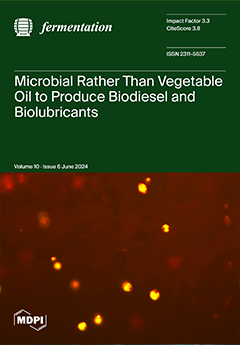In classical methods of wine production, amino acids play a critical role, as they are fundamental to all types of fermentation. Beyond their consumption in fermentative processes, amino acids undergo several transformations, such as decarboxylation, which produces biogenic amines. These biogenic amines can increase under certain conditions, such as the presence of spoilage bacteria or during malolactic fermentation. Alternative methods of vinification were applied, using sulfur dioxide as a preservative (+SO
2) and methods without added sulfites. Alternative methods of vinification were applied using sulfur dioxide as a preservative (+SO
2) and methods without added sulfite (−SO
2). Monitoring was conducted for Cabernet Sauvignon red (CS), Cabernet Sauvignon rosé (CSR), Fetească regală still (FR), and Fetească regală frizzante (FRF). Alternative procedures employed the use of
Pichia kluyveri for its ability to block the oxidation reactions of grapes, malolactic fermentation for all wines without sulfur dioxide (−SO
2) to ensure superior stability, and the use of several tannin mixtures to avoid oxidation reactions. Correlations were considered between the amino acids and biogenic amines that have a direct relation through decarboxylation or deamination. The pH of the wines, total acidity, and volatile acidity as principal factors of microbiological wine evolution remained constant. The highest mean concentrations of the detected biogenic amines were putrescine at 23.71 ± 4.82 mg/L (CSRSO
2), tyramine at 14.62 ± 1.50 mg/L (FR-SO
2), cadaverine at 4.36 ± 1.19 mg/L (CS-SO
2), histamine at 2.66 ± 2.19 mg/L (FR + SO
2), and spermidine at 9.78 ± 7.19 mg/L (FR + SO
2). The wine conditions ensured the inhibition of decarboxylases, but some correlations were found with the corresponding amino acids such as glutamine (r = −0.885,
p < 0.05) (CSR-SO
2), tyrosine (r = −0,858,
p < 0.05) (FR-SO
2), lysine (r = −0.906,
p < 0.05) (FR-SO
2), and histamine (r = −0.987,
p < 0.05) (CSR-SO
2). Multivariate analysis was performed, and no statistical differences were found between samples with (+SO
2) and without added sulfur dioxide (−SO
2). The vinification conditions ensured the wines’ stability and preservation and the conditions of producing biogenic amines at the lowest levels in order to not interfere with the olfactive and gustative characteristics.
Full article





